
Contact page design: best practices and examples
Apr 10, 2024
It takes more than an eye-catching design and a few blog posts to build an effective B2B website. The user journey, design, messaging, performance, and structure all play their own part when it comes to creating a website that supports lead generation and builds opportunities in your pipeline.
To generate more leads from your website, it's crucial to optimise it for search engines.
This means doing keyword research and incorporating relevant keywords into your website content. By improving your website's visibility in search results, you'll attract more organic traffic and increase your chances of generating leads.
Another important aspect of search engine optimisation is creating high-quality, informative content, like pillar pages. This not only helps with SEO but also establishes your expertise and builds trust with visitors, making them more likely to convert into leads.
Remember to optimise your meta tags, title tags, and headers as well. These elements contribute to your website's search engine optimisation and can help improve your rankings.
A well-structured B2B website uses clean and intuitive navigation. In fact, 94% of people agree easy navigation is the most important website feature.
Current website best practice dictates that you put your service pages in your primary navigation to help visitors quickly find your most valuable products and services. Ensure visitors are never more than a couple of clicks away from the information they need. This will increase the average time on site and make it easier for search engine crawlers to navigate and classify your pages.
Not sure how to organise your main navigation? Consider visitor intent.
High-value pages, like your product and service pages, should feature prominently. Resist the temptation to put everything into one huge navigation bar. You don’t want to overwhelm visitors the first time they visit your site. In our experience, pared-back navigation that focuses on the content that's critical for purchase improves engagement and increases bottom-of-the-funnel conversions, which leads us to the importance of calls to action (CTAs).
When it comes to CTAs in your navigation, you want to make sure they grab visitors' attention and get them excited to take action. Your high-intent offer, whether it's a free trial, a demo, or a conversation with sales, should be front and centre, enticing those serious buyers to take the next step.
Calls to action aren't only effective for bottom-of-funnel offers in your navigation. Including them throughout your website is key to generating more leads.
CTAs prompt visitors to take a specific action, such as signing up for a newsletter, downloading a free resource, or requesting a consultation.
HubSpot identifies two main types of CTA: primary and secondary.
A primary CTA is the main action you want users to take when they visit your site. It should appear in a prominent position on every page – in your main navigation, for example. A typical primary CTA could be:
.jpg?width=696&height=358&name=Partful-cta%20(1).jpg)
Partful's primary CTA, Book a demo, stands out at the top of our site and appears on every page.
Secondary CTAs are more contextual. As the name suggests, they provide alternative actions visitors can take. For example, you might include a CTA at the end of a blog that encourages them to download a guide or read a related piece of content.
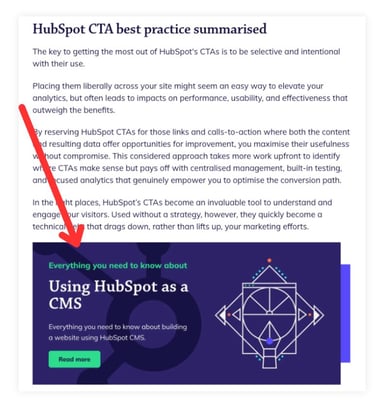
We recommended including a CTA at the bottom of every blog to give visitors a relevant next step.
Placement, relevance, and wording are key to creating CTAs that converts.
Your primary CTA should be clear and prominent so there’s no confusion about the action you want visitors to take. Secondary CTAs should be relevant to the topic at hand, so you can deliver the right content, at the right time.
What makes a good CTA?
- Be specific and predictable. Your audience should know exactly what they'll get when they click on your CTAs.
- Show the value of your content. "Read our introduction to B2B inbound marketing and learn how to generate leads" is more effective than a simple "read our introduction to B2B inbound marketing".
- Stimulate action. Use imperative verbs like "explore" or "request" to give visitors agency and encourage them to act.
- Consider context. Use the right CTA for the right piece of content. For example, it doesn't make sense to include a CTA on cloud security in a blog about cost optimisation.
Adding social proof to your website is a powerful way to generate more leads. Social proof refers to the influence created when people see others engaging with your brand or products/services. It builds trust and credibility, making visitors more likely to become leads.
There are several ways to incorporate social proof into your website:
Aggregated reviews: websites that have real customer reviews like Trustpilot and G2 are great for showcasing positive feedback and ratings, demonstrating the value and quality of your offerings.
Customer logos: association with well-known clients or partners can instil confidence in potential leads and make them more comfortable reaching out to you. It's like saying, "Hey, if these big names trust us, you can too!".
Testimonials: sharing quotes from real satisfied customers not only showcases your expertise but also creates a personal connection with your audience. These are more powerful if you include the full name, title, and company of the person.
Case studies: by showcasing specific examples of how you've helped clients achieve their goals, you provide concrete evidence of your capabilities. Potential leads can see themselves in these success stories and envision the benefits they could reap by working with you.
Accolades and awards: if you've received recognition for your industry expertise or excellent service, don't be shy about displaying it. It shows that others have acknowledged your hard work and validated your position as a leader in your field.
Accreditations: if your business has earned any certifications or accreditations, make sure to highlight them on your website. These credentials demonstrate that you meet certain industry standards and can be trusted to deliver quality products or services.
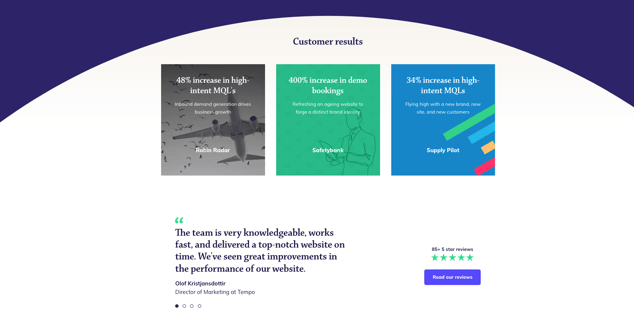 In this example, we're using a variety of social proof, case studies, testimonials, and aggregated reviews.
In this example, we're using a variety of social proof, case studies, testimonials, and aggregated reviews.
It takes the average person between 3-5 seconds to decide if they want to stay on your website. So to convert leads, you must structure your pages in the most engaging and user-friendly way possible.
This starts at the top. Create a header that clearly and succinctly communicates your value proposition, so visitors understand instantly what you do and who it’s for. Reinforce your value proposition with a hero image or other visual element that catches the reader’s eye.
The main body of the page is where you can provide visitors with a bit more information about your products and services. Don’t get bogged down in specifics. Less is more where web copy is concerned. Focus instead on these key areas:
Forms are often used to capture visitor information, such as email addresses or contact details, and provide an opportunity to get something in exchange for their submission. This might be a demo, conversation with sales, piece of content, or registration to your webinar.
To optimise your form completion rate, keep them short and simple where possible. Only ask for essential information that is necessary for your lead generation efforts. Long and complex forms can deter visitors from completing them.
On the other hand, if you're willing to trade quantity for quality, longer forms can sometimes indicate a stronger desire to purchase from you. So don't be afraid to ask for a little more information if it means attracting more committed leads.
Make sure it's clear what's going to happen after completing the form. You don't want your visitors to feel like they're entering a black hole of uncertainty. It's important to set clear expectations and let them know exactly what they can expect after submitting their information.
Top tip: try including a contact form in your footer. You may have an unused blog subscribe form or something else down there currently, so you may as well use that important real estate for something more useful. A footer contact form allows buyers to submit an enquiry right within the context of the page they're reading. It's a small tweak that can have a big impact on your lead-generation efforts.
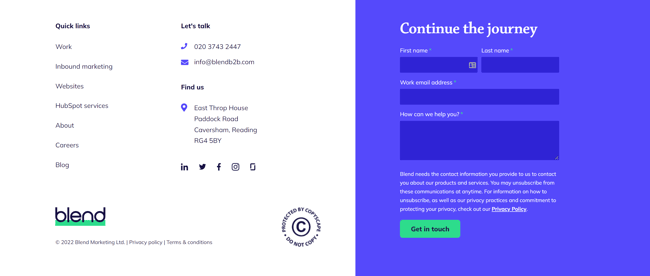
The contact form in our footer invites visitors to learn more about our services within the context of the page they're on.
A/B testing is a powerful technique for optimising your website and generating more leads. It involves comparing two versions of a webpage or element to determine which performs better in terms of conversions.
To conduct A/B testing, identify a specific element you want to test, such as a headline, CTA button, or page layout. Create two variations of the element and randomly show each version to different visitors. Track and analyse the results to determine which version yields higher conversion rates.
A/B testing allows you to make data-driven decisions and continuously improve your website's performance. It helps you identify what resonates best with your audience and optimise your lead-generation efforts accordingly.
Remember to test one element at a time to ensure accurate results. Be patient and conduct tests over a sufficient period to gather reliable data.
Many factors can affect website performance and impact customer experience. For many visitors, your website is the first interaction they have with your business, and the experience can make or break their perception of your brand.
A slow, poorly optimised website can make you look unprofessional. Some visitors may even question the level of security on your site. It can also affect visitor retention and SEO.
Prolonged load times breed frustration. Google research found that bounce rates increase by 32% when load times increase from 1-3 seconds. And while page speed isn't as important as relevance when it comes to search ranking, poor performance can negatively impact traffic, lead generation, and conversion.
According to Portent, website conversion rates drop by almost 5% with each additional second of load time.
To maximise your chances of ranking in SERPs, you must ensure your website loads fast and performs well.
How to improve the performance of your website:
- Choose the right CMS – one that provides 24/7 support, fast page load speeds, and built-in security features.
- Deliver content over HTTP2
- Use a content delivery network (CDN)
- Implement effective browser caching
- Compress graphics, images, and videos
Many businesses shy away from displaying their pricing on their website, even if they can do so. This is often driven by a fear that competitors might snatch up your pricing information or gain too much insight into your offerings.
However, if you can include pricing information on your website, it can significantly improve lead generation. Transparency about pricing builds trust with visitors and allows them to make informed decisions.
According to research conducted by Nielsen Norman Group, prospective customers want to know the price as their #1 info need on any website — including B2B sites.
So, how should you display your pricing?
Consider displaying pricing tiers or options that cater to different customer needs. Communicate the value and features included in each pricing plan. If your pricing structure is more complex, try providing a sample price, or from price, with a contact form or a call-to-action for visitors to request a personalised quote.
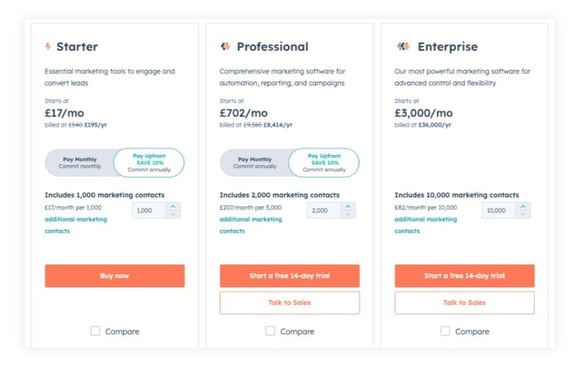
HubSpot's pricing is clear and dynamic, giving a personalised feel.
Visual content is a powerful tool for generating more leads from your website. Adding product imagery or demos allows visitors to visualise the benefits and features of your offerings, increasing their desire to learn more and potentially convert into leads.
Include high-quality images that showcase your products or services from different angles or in various use cases. If applicable, incorporate videos or interactive demos that provide a more immersive experience.
Accompany the visuals with compelling and informative descriptions that highlight the unique selling points of your offerings. Clearly communicate how your products or services solve a problem or meet a need.
Consider incorporating customer testimonials or reviews alongside the product imagery or demos. This further enhances the social proof and builds trust with potential leads.
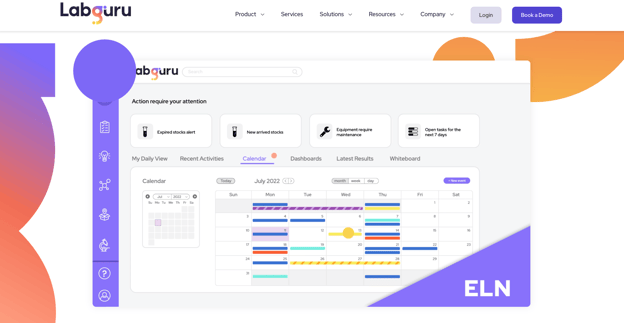
Labguru have an overview video on the homepage that demonstrates the power of their platform.
Today, an effective B2B website is one that generates qualified leads for a business. Getting the above elements right will not only help you generate more leads through your website but also create a high-performing marketing asset that will continue to delight your visitors.